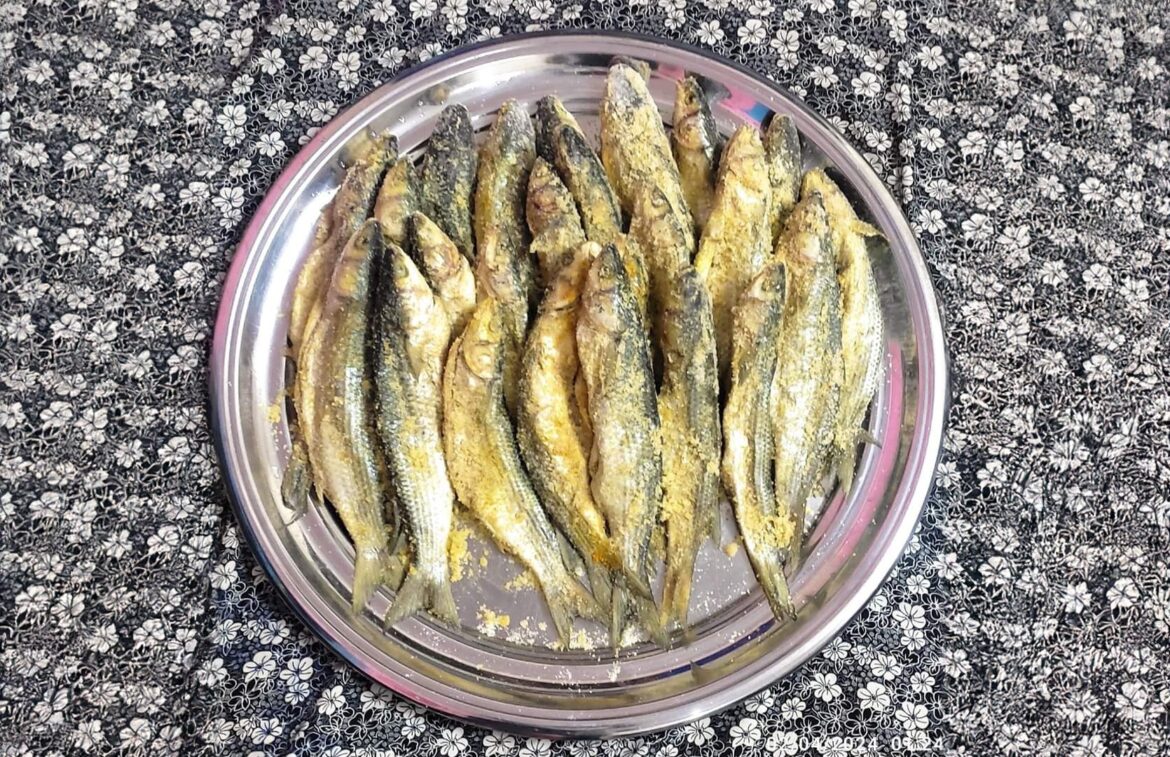Spring is the season of prosperity, greenery, and pleasant air. This is how spring always came for the people of Gaza, before the life of tents and shelters robbed them of their simplest wishes to enjoy fresh air and a cool breeze that relieves them of the scourge of high temperatures.
Spring was different with its celebrations, food, and rituals that the Gazans experienced on their land before they were forced to leave it. Although “Sham El-Nessim” is an Egyptian Pharaonic custom, the Gazans and Egyptians have a common history, heritage, and even a common cuisine. Its most prominent features are herring and Ghazawi fesikh.
The Gazan exodus to Egypt brought with it much of the legacy of Palestinian food. Many Gazans in Egypt excelled in preserving their traditional ways of celebrating various occasions, especially holidays and the Sham El Nessim celebration, which began on the last Friday of April.
The Palestinian Feseekh competes with the Egyptian in the spring holidays
Despite the sadness evident on the faces of the people of Gaza in Egypt, they continue to resist by reviving their heritage of the foods associated with it during the holidays and Sham Al-Nessim.
“Herring and fesikh are essentially Egyptian foods, but they have been on their way to Gaza for many years, and there we added our own flavor to them, which gave them a special taste that all the people of Palestine know,” says Abu Ahmed, 40 years old, who used to work in the construction field in Gaza, before he left. He specializes in pickling and selling herring and Gazan fesikh in Egypt.
Abu Ahmed tells Tel Aviv Tribune Net that the main difference between Egyptian fesikh and Palestinian fesikh lies in the Gazan spices and turmeric that are added for salting, in addition to the fact that it is fried in hot oil before it is fully cooked.
While mullet fish is used in making Egyptian fesikh, the people of Gaza use jarr fish, or what is known in Egypt as “loon” fish, but although it is rare in Egypt, Abu Ahmed used mullet fish with large quantities of turmeric, safflower and salt for cooking.
In Gaza, fesikh is served either fried after it has cooked in pickling, or served with stew, which consists of putting tomato juice plus onions and garlic in the oil in which the fesikh was previously fried and salt and cumin are added, and it is served hot as a side dish with the fried fesikh.
As for Gazan herring, it also differs from its Egyptian counterpart, which is mostly imported, but Gazan herring is made from mackerel, which is a fish that comes from Scandinavian countries, and unlike Egyptian herring, which is sold enclosed, with its entire entrails, and Egyptians accept to eat its entrails, or what is called “ Roe, and the price of herring increases whenever the “roe” is rough and not smooth.
As for Gazan herring, it is sold cleaned of the entrails and does not contain the roe. Abu Ahmed says, “We wash the fish, clean it well, soak it in salt for about 12 hours, then smoke it for 6 hours, then keep it in the refrigerator.”
Al-Ghazawi refrigerator…a refreshing drink with lemon spirit
And it is not only with fesikh and herring that Al-Ghazawi preserves his legacy of Palestinian food. With the beginning of the rise in temperatures, the so-called “Palestinian refrigerator” became popular on social networking sites, which is a small bag containing various ingredients to make a refreshing juice suitable for the hot climate experienced by Cairo and the various governorates of Egypt.
The famous Gaza juice consists of an essential ingredient called “refrigerator spirit,” which is the substance contained in the small bag that is sold in Cairo for 90 Egyptian pounds (1.88 US dollars), which is enough for about 50 cups.
Al-Ghazawi refrigerator juice consists of about 1.5 liters of milk, 9 lemons, two tablespoons of powdered milk, a tablespoon of starch, 4 drops of Al-Ghazawi spirit “known as Gaza,” and a teaspoon of saffron color or Al-Ghazawi dye if available. The refrigerator has been sold. Al-Ghazawi received great demand in Egypt, from Palestinians and Egyptians who came to try the most famous refreshing drink in Gaza.
Thyme, olive oil, and the Palestinian “Majdalawi” paste with olive oil and black seed are also among the Palestinian foods that the people of Gaza in Egypt are keen to keep with them, says Sabreen Abdullah (27 years old), who came with her family from Gaza to Cairo a week before the beginning of the month. Ramadan, she was keen to carry thyme and olive oil with her from Gaza to Cairo, and she did not know that it would be a source of livelihood for her and her family, but when she carried it, she only thought that it would be food available when stomachs were empty.
Sabreen added to Tel Aviv Tribune Net, “I carried it with me to Egypt, and when we arrived we forgot hunger after the people of Egypt included us in their care. I thought of exploiting the quantities that I carried with me from Gaza to be my source of livelihood, then I started making it at home after the demand for it increased.”
From dried thyme, sumac, sesame, ground cumin, caraway, and olive oil, Sabreen makes her distinctive mixture of Gazan thyme, and sells it for 260 pounds per kilogram.
Although Egyptian cuisine is not accustomed to thyme, it has witnessed recent popularity since the arrival of the Syrians to Egypt, and the spread of Syrian food stores that serve manakish with thyme as part of the food appetizers, in addition to the main dish of thyme with olive oil.
Although Palestinian dishes are new to Cairo, the appetite of Egyptians is still waiting for more of them in a way that reflects the mixing of Palestinian and Egyptian cultures.



